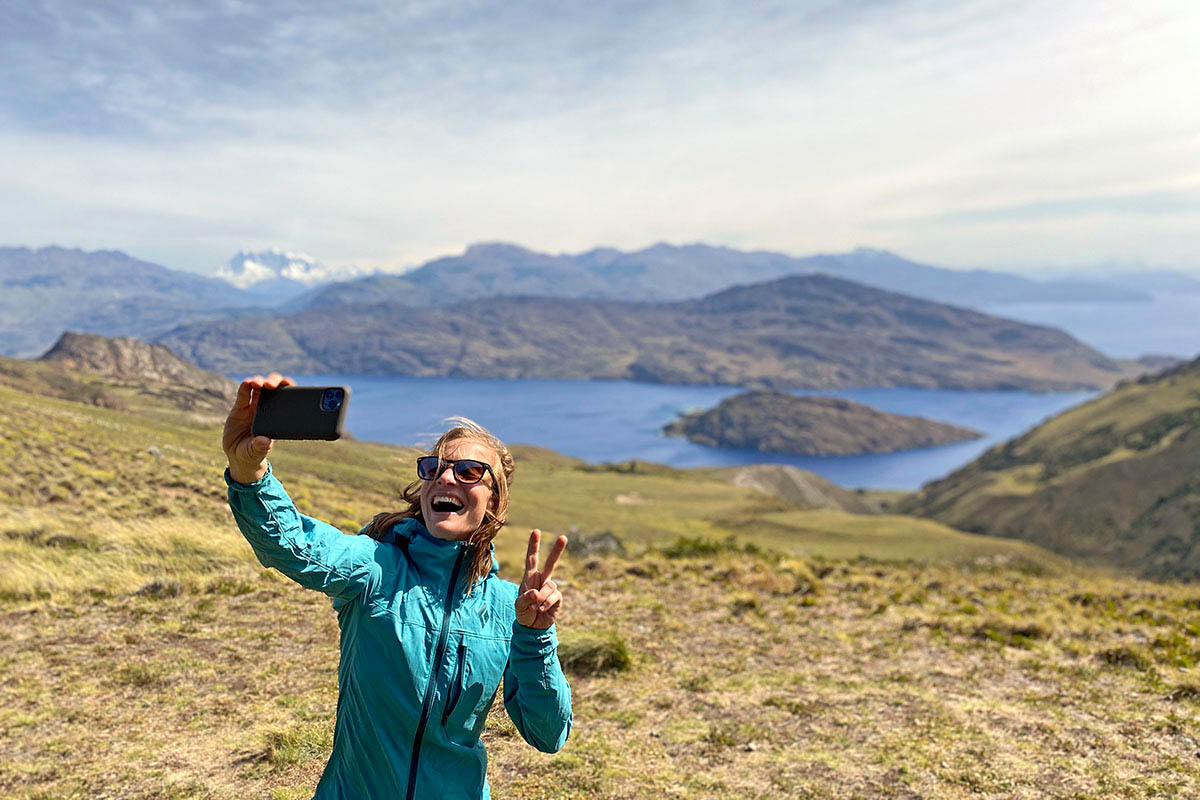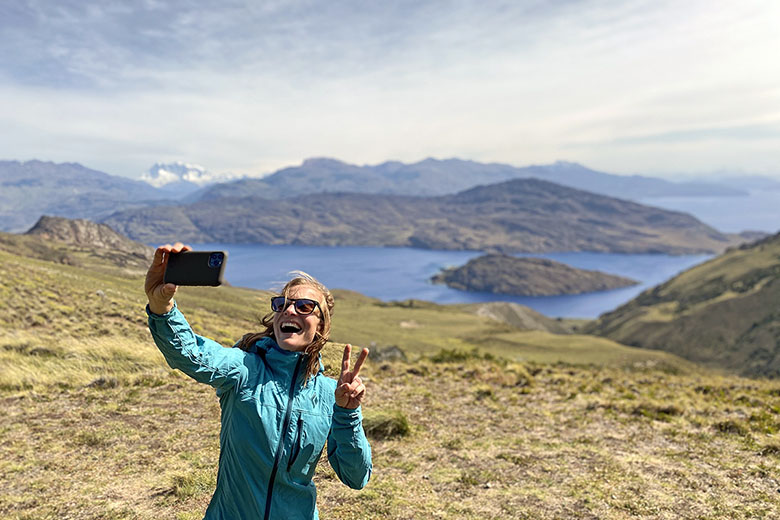

Switchback Travel


Switchback Travel
The time could have been 9pm or 5am, and we wouldn’t have known the difference. It was a clear, mid-June day in the land of the midnight sun. The warm orb hung high in the sky as I pulled onto the summit block, trailing a climbing rope in my wake. Waves of granite and snow cascaded below in an array of effortlessly organized chaos. To the north loomed Denali, a stark white mass with hundreds of other jagged peaks in the foreground, rising from myriad valleys below. In this isolated part of the Alaska Range, there was no sign of another soul, as far as the eye could see. Belaying my partner up, I felt like the queen of the castle: our domain was the entire breadth and depth of the Alaska Range, and we had it all to ourselves.
Later, we’d hear that over 60 climbers summited nearby Denali that day, a perfect weather window aligning with perfect snow conditions. And that number represented just a fraction of the people on the mountain: Denali’s West Buttress has been known to see up to 500 climbers at a time. The other Seven Summits aren’t any lonelier: many of us have now seen the famous photo from the 2019 season on Everest, showing almost 100 climbers in a literal human traffic jam below the Hilary Step. Do a Google search for Kilimanjaro, and you’ll find a one-star Trip Advisor review that cites, “…a crowded experience on the trail, at the camp sites and a single-file summit attempt with pushing at the top for a private photo at the summit.” If you’re looking for wilderness or adventure, you won’t find it on the tallest mountains in the world.
And you don’t have to be a climber to grasp the predicament. Perhaps your Denali is the Enchantments of Washington State, Trolltunga in Norway, or the Cables Route on Half Dome. It could be The Wave in Arizona, Jenny Lake in the Tetons, Maine’s Mount Katahdin, and the list goes on and on. If you’re looking for that coveted wilderness or adventure, you won’t find it in these exceptionally special places either. In the deadly algorithm of beauty, accessibility, and online virality, some of our most cherished landscapes have turned into tourist destinations resembling amusement parks at best, and city subway stations at worst.
Geotagging has, of course, taken the brunt of the blame for overcrowding, hand in hand with its evil stepsister, Instagram. In a 2017 article that went viral, Outside Magazine asked the question, “Is Instagram Ruining the Great Outdoors?” sparking a conversation about the dangers of sharing photos with GPS coordinates attached. Jackson Hole’s tourism board recently spearheaded an entire campaign around the phrase: Tag Responsibly, Keep Jackson Hole Wild. And then there’s stories of imperiled natural beauty at the hands of Instagram fame, like the sunflower farm in Ontario and the real-life parable of The Broccoli Tree. If there’s one easy place to point the finger for the hoard of people on your next vacation, it’s geotagging—which logically brings us to one simple solution: don’t geotag.
But withholding from geotagging is a mere Band-Aid, a dumbed-down response to a much larger issue. In this Insta Repeat culture, we’ve become consumers of the outdoors, battling like Black-Friday shoppers for the shot, the bragging rights, the checkmark on our bucket lists. Tossing elbows and bemoaning crowds, lines, and full parking lots, we voraciously hunt and gather experiences, missing out on the true depth of experience our natural surroundings provide. Is there value to abstaining from geotagging to protect lesser-known locations? Absolutely—and imperatively—yes. But lest you grow too smug in your secrecy, understand that the antidote to outdoor consumerism is more of a mind shift than a thumb tap.
The antidote to outdoor consumerism is relationship. And what kind of relationship are we seeking when our mode of engagement with the natural world looks more like speed dating than a long-term commitment?
Perhaps most known for his best-selling book The Emerald Mile: The Epic Story of the Fastest Ride in History Through the Heart of the Grand Canyon, Kevin Fedarko lives in New Mexico and works as a part-time river guide in the Grand Canyon. Pete McBride is a Colorado-native and award-winning photographer and filmmaker who once followed the Colorado River from source to sea. Both men are incredibly well-traveled and well-versed in the outdoors—not to mention well-published—but in recent years have returned to the Southwest to make the area in and around the Grand Canyon home. Fedarko and McBride believe that the best way to enjoy the outdoors is to know it intimately—rather than skimming the surface of myriad areas, they’ve chosen to grow their roots deep.
In an October 2019 presentation at the Boulder Theater in Boulder, Colorado, Fedarko undermined the pervasive cultural notion of visiting national parks to check them off a list. Instead, he talked about developing a deep relationship with one or two places—going there multiple times in different seasons, taking your kids, and eventually maybe their kids.
Over the course of the past few years, Fedarko and McBride thru-hiked 750 miles across the length of the Grand Canyon. Consider the contrasts between this sort of exploration and the rampant collection of paved vistas and tourist sites along the canyon rim. The pair of adventurers weren’t contending with hundreds of other visitors during their journey, but they were surely finding their fair share of “Instagrammable moments.” And rather than taking the photo and driving to the next viewpoint, they got to relish nuance and detail—the way the hue of the Colorado’s water grows deeper in the spring, the smell of the desert after a rain, the arc of the sun through the changing seasons.
Over and over, studies have shown that people with strong relationships are happier and live longer. And while these studies certainly imply person-to-person relationships, it would follow that a connection with a given landscape can foster the same sort of well-being. And perhaps most importantly, action springs out of this sort of connection. Those who know and love a given land are often the ones who will fight to protect it the most.
You don’t have to be a big-time adventurer or live beside the Grand Canyon to choose relationship over speed dating with the outdoors. What would happen if we all took a look at our bucket lists and swapped "Famous Outdoor Tourist Destination A" with a more intimate and personal exploration, exploration that demands more ingenuity and thus, offers more reward in return? How would your next vacation be different if (instead of fighting for parking spots and taking in views alongside hundreds of other strangers) you made it a game—with your friends, family, or yourself—to connect rather than consume: to learn about an area, to take time to enjoy a few special spots, to possibly even give back?
Back in Denali National Park, following our solstice summit-for-two, my partner and I loaded up backpacks with overnight gear, four days of food, packrafts, and paddles, and began our journey out of the Alaska Range. Our traverse took us from glacier and moraine to tundra and thick rainforest, swapping crevasse cracks for grizzly tracks. At the banks of a wild Alaskan river, we inflated our rafts and set off into the silty, swift-moving water that would bring us back to civilization. We laughed with fatigue, cried in frustration, and continually marveled at the grandeur of the Alaskan wilderness. In the end, it was an adventure of the most epic proportions. The time, ingenuity, and effort we put into planning our trip paid us back tenfold.
Once back in Talkeetna, the jumping-off town for the Alaska Range, we found ourselves at the town’s de facto watering hole, the Fairview Inn. The bar swarmed with climbers, many who had just flown off of Denali that afternoon after successful summit bids. My partner and I struck up conversation with a crew from a guided expedition, strangers from far and wide who had assembled for a chance at North America’s highest point. “I’m so glad we got the weather window,” one said, “I would have hated to come back. But I got the tick! My fifth out of the Seven Summits.” Drunk with the relief and accomplishment of our adventure, spinning with the knowledge of intense effort and the euphoric reward, I struggled to compute this climber’s perspective. I just completed the journey of a lifetime, and this man, amidst a crowd of 60 strangers, had gotten his “tick.”